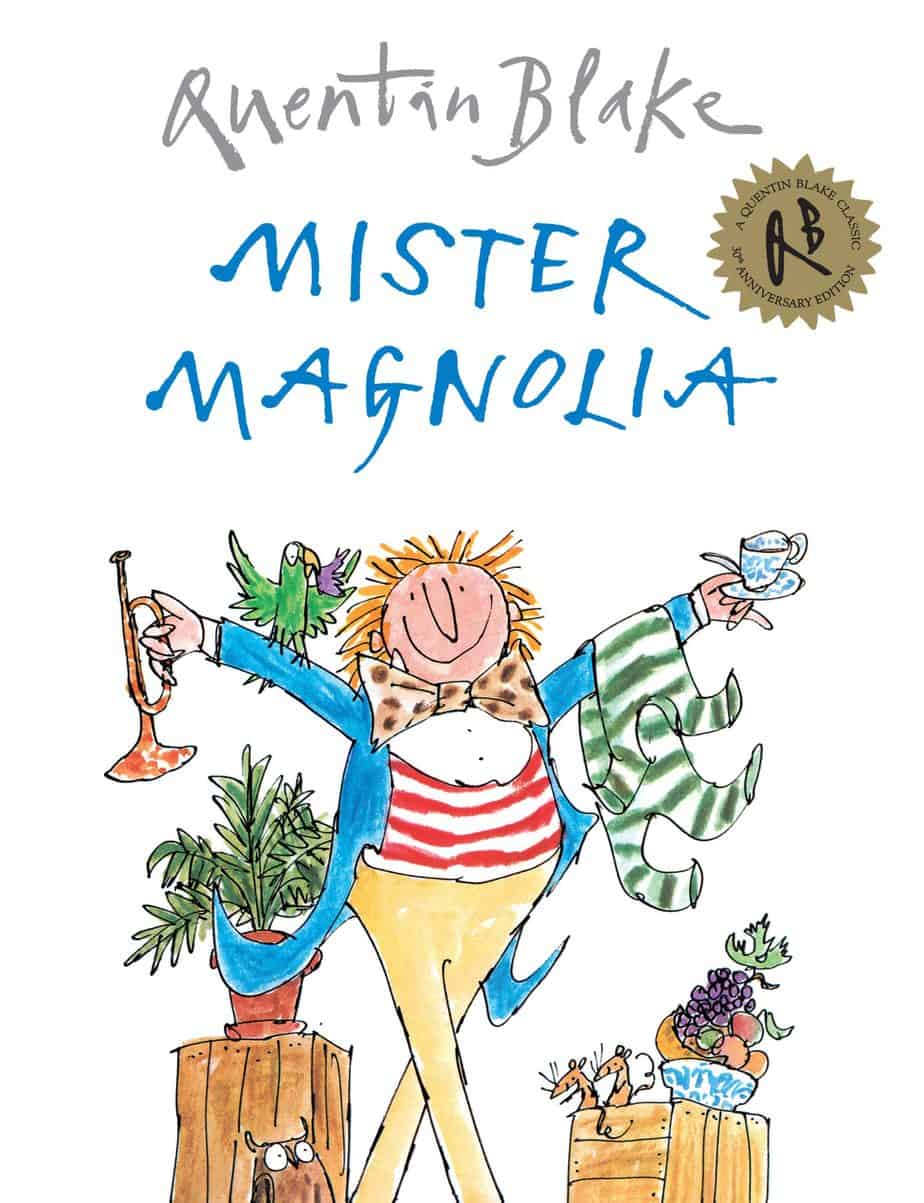Mister Magnolia is a picture book written and illustrated by Sir Quentin Blake. It won the Kate Greenaway Medal in 1980, and the Red House Children’s Book Award in 1981. This story is an excellent lesson in simplicity. Even the rhyming is simple; everything rhymes with ‘boot’.
Boots And Scooters
The illustration below reminds me of a story my father tells from his 1940s childhood. He and his siblings desperately wanted kick scooters, which were all the rage in New Zealand, despite having been invented in Germany way back in the early 1800s.
But their father, my grandfather, said a hard no to scooters. Reason being, scooters would wear out only one boot. So they got bikes instead. (Bikes without brakes, I might add.) Back then, shoes were super expensive. I’d assumed the ‘wearing out one boot’ reason for eschewing the scooter was specific to my paternal grandfather, but Quentin Blake is the same vintage as my father and, after reading Mister Magnolia, I now wonder if parents of the early 20th century commonly believed that the scooter would result in assymetrical wear and tear to their kids’ boots, breaking the working class family’s budget.
Quentin Blake never gives us the backstory as to WHY Mister Magnolia wears only one boot, but I deduce it’s because he completely wore it out from kick scooting all over the show. This despite my own experience of scooter riding (I never had one as a kid for the SAME REASON my father never had one). But we did buy one for our kid, and I’ve given it a whirl. I find myself alternating feet constantly because one gets a bit tired. I’m not even ambifooted. (Has anyone done a study on this?)
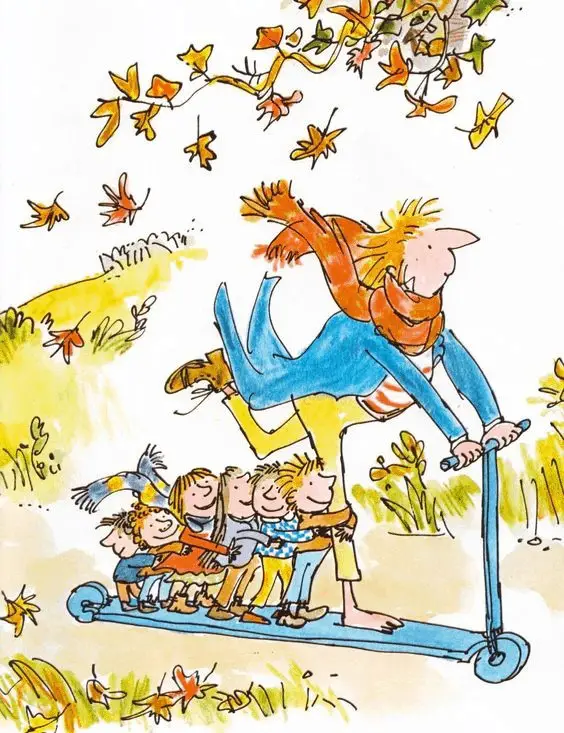
CARNIVALESQUE STORY STRUCTURE OF MISTER MAGNOLIA
PARATEXT
Mr Magnolia has only one boot.
He has an old trumpet that goes rooty-toot –
And two lovely sisters who play on the flute –
But Mr Magnolia has only one boot.In this wittily rhyming picture book, Mr Magnolia has a full and happy life except for one serious omission – a boot. But one day, he receives a mysterious parcel, and at last Mr Magnolia can splash in the puddles with everyone else!
marketing copy
Notice how the front cover is a full-body shot of the main character… minus his feet. If the cover showed him wearing only one boot, that would ruin the surprise of the opening page… in which we are told he wears only one boot.
Notice how seldom characters are depicted in long shots minus only their feet. Very seldom. In general, it’s not recommended. It’s not a typical shot at all, and the super careful reader will know even before opening the cover that something’s going on with the guy’s feet. It’s not something we notice consciously, though.
Emphasis on the feet is a fairytale trope of yore, but usually it’s kinda gruesome. The character will look normal but have chicken feet or something. In this contemporary picture book for very young readers, Blake takes that trope and makes it fun.
A fun picture book will very likely have a carnivalesque story structure, so that’s what I’m using here to analyse the story.
Carnivalesque stories look a bit different when the star is a child hero. Below I go into how a carnivalesque story works when the main character is an adult.
An Every Child is at home
Mr Magnolia is in the body of an adult but he is a child stand-in. For our purposes he is the child. Blake first depicts him inside the house, and tells us a little about his home.
Mister Magnolia may be a child archetype but he is not the EVERY child by dint of him being an eccentric. This book is basically a character study of a wacky figure.
What I really appreciate about stories Quentin Blake has both written AND illustrated himself: They are kinder than the stories he illustrated for Roald Dahl and Roald Dahl’s chosen successor, David Walliams. For instance, Roald Dahl was hard on fat people. (This despite being an irrepresible sweet tooth and tobacco addict himself.) But in Quentin Blake’s Mister Magnolia, we are told that Mister Magnolia has two lovely sisters. And they are not both slim! One is large, the other small, and they are BOTH lovely. This simply would not happen in a Roald Dahl story, with the exception of the Grandmother figure in The Witches. (Grandmothers are exempt from female beauty standards, and the grandmother of The Witches does not conform to feminine expectations of behaviour.)
The Every Child wishes to have fun.
Mister Magnolia is shown having lots of fun. He scoots through the park with children clinging onto his leg and so on and so forth. The fun of this book derives from watching Mister Magnolia have fun. He is more fun than a child figure because of the comical juxtaposition: Like a hat wearing a dog, grown-ups don’t normally have this kind of fun.
Appearance of an Ally in Fun
An adult character doesn’t require a Cat In The Hat figure to accompany them on their journey into fun because an adult has all the freedom they need to leave the house, live on their own, etc. Mister Magnolia’s ‘allies in fun’ are children.
Hierarchy is overturned. Fun ensues.
I do wonder if a story like this would be published today. When Quentin Blake was creating Mister Magnolia at the end of the 1970s, there were still plenty of men in primary school teaching. The 1980s saw a rapid and permanent exodus of men from teaching as parents became more aware of sex abuse crimes against children. Suddenly, what had earlier been hidden, precisely because it was unthinkable to non-pedophiles, became a fleshed-out fear in the minds of parents, and book-buyers everywhere.
What sort of man plays with other people’s children in the park? I personally rail against the idea that men playing with kids in children’s books should be avoided to spare those particular feelings of discomfort in adult gatekeepers. Men need to be more involved in childcare before equality is achieved, and if kids themselves grow up thinking that men are not the natural playmates of kids, that’s a problem for the next generation of fathers, step-fathers, uncles and male teachers.
Fun builds!
The fun does build, but Quentin Blake adds pathos to this carnivalesque romp by inducing audience sympathy for the poor Mister Magnolia who can’t go outside in the rain because he’ll get a wet foot. This is magnificent, because children will identify with the frustration of being stuck inside because of inclement weather.
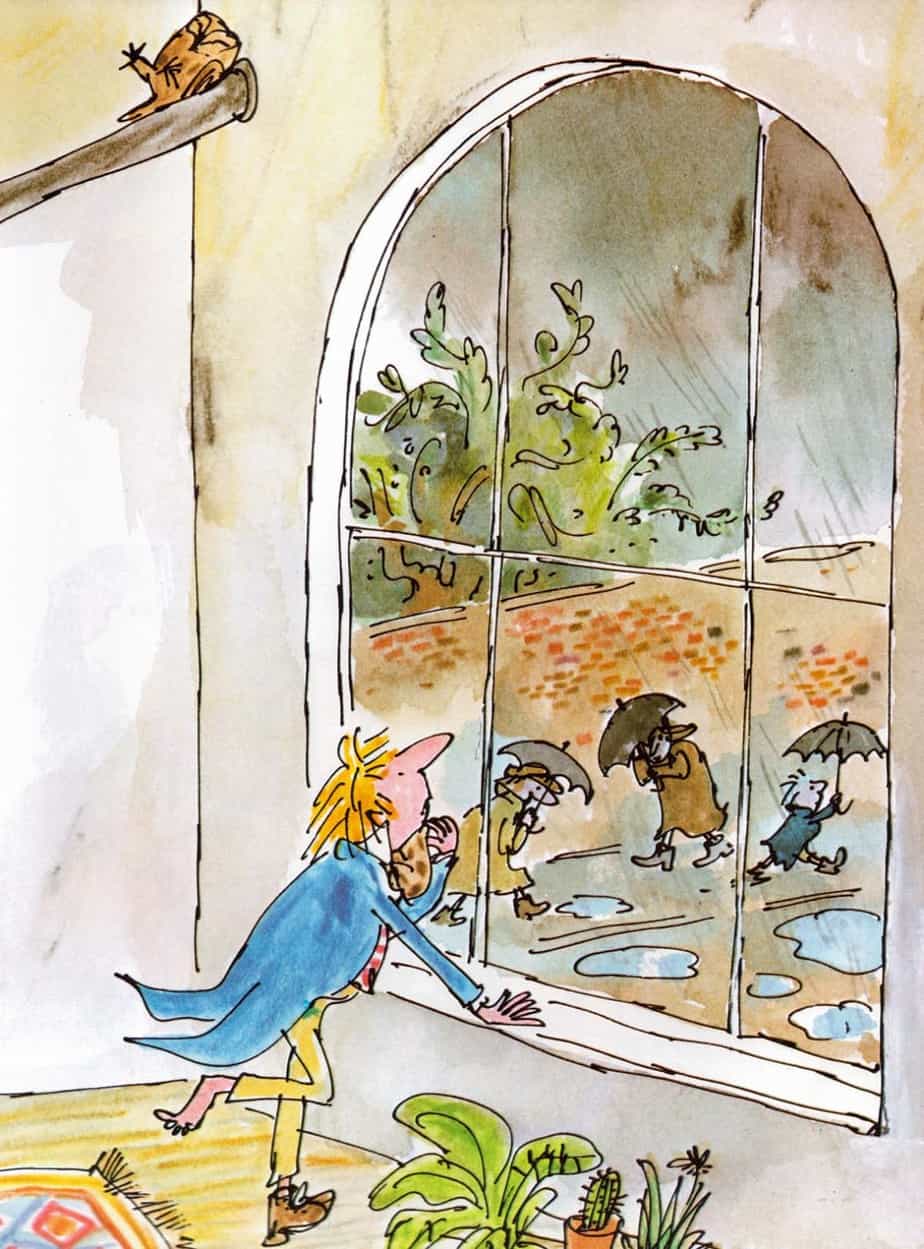
Notice that as the fun builds, Mister Magnolia’s pets get more and more unlikely. Okay, we believe he has birds (another feminine attribute in art is to be surrounded by birds), but eventually we find he has a pet dinosaur (not just an unlikelihood, an impossibility).
Peak Fun!
In a more modern carnivalesque picture book, at least if we look at the bestsellers, the end to the carnivalesque romp will be a gag or a joke of some kind. Take a look at Stuck by Oliver Jeffers for a good example of what I’m talking about.
I was wondering how Blake was going to end this one. And because I’ve read a lot of contemporary carnivalesque picture books, I was half-expecting a Ha! moment. But that’s not Quentin Blake’s MO. He writes with what we might call a feminine sensibility. To clarify, and avoid gender essentialism: Quentin writes stories about kindness, and girls, more than boys, are acculturated to be kind by the types of games we expect thme to play (e.g. tea parties), and by the books we expect them to read (e.g. domestic stories rather than swashbuckling adventures).
Other wits have noted that masculine stories emphasise the climax, while feminine stories emphasise the build-up. Although the ‘gag’ ending is popular at the moment, and almost entirely written by men in children’s publishing, here’s what’s true about joke climaxes: They’re funniest the first time. Really good jokes don’t stop being funny, of course, and the difficult trick of picture books is to write a really good, repeatable gag. But Blake’s Mister Magnolia is an excellent example of a carnivalesque picture book that doesn’t end in a climactic gag. The jokes have been drip fed to us all through the story, and although this is an excellent rhyming read-aloud which encourages the reader to keep turning the page, the repeat-reading joy comes from really studying the humorous details of the story in subsequent sessions.
Avoiding the climactic joke, the romp in this book ends with a girl gifting Mister Magnolia a boot. Quentin Blake slows down the pace and builds up suspense as Mister Magnolia slowly opens his gift. (That’s why we wrap gifts in the first place, right? Suspense!)
Magnificently, the boot does not match his other one. But he is delighted with it, and so are we, because now Mister Magnolia is free to roam no matter the weather.
Return to the Home state
The final image is of Mister Magnolia in bed. He is very clearly a child archetype. He sleeps in a single bed, and like picture book children everywhere, his fun ends with him safely tucked in his own bed, asleep.
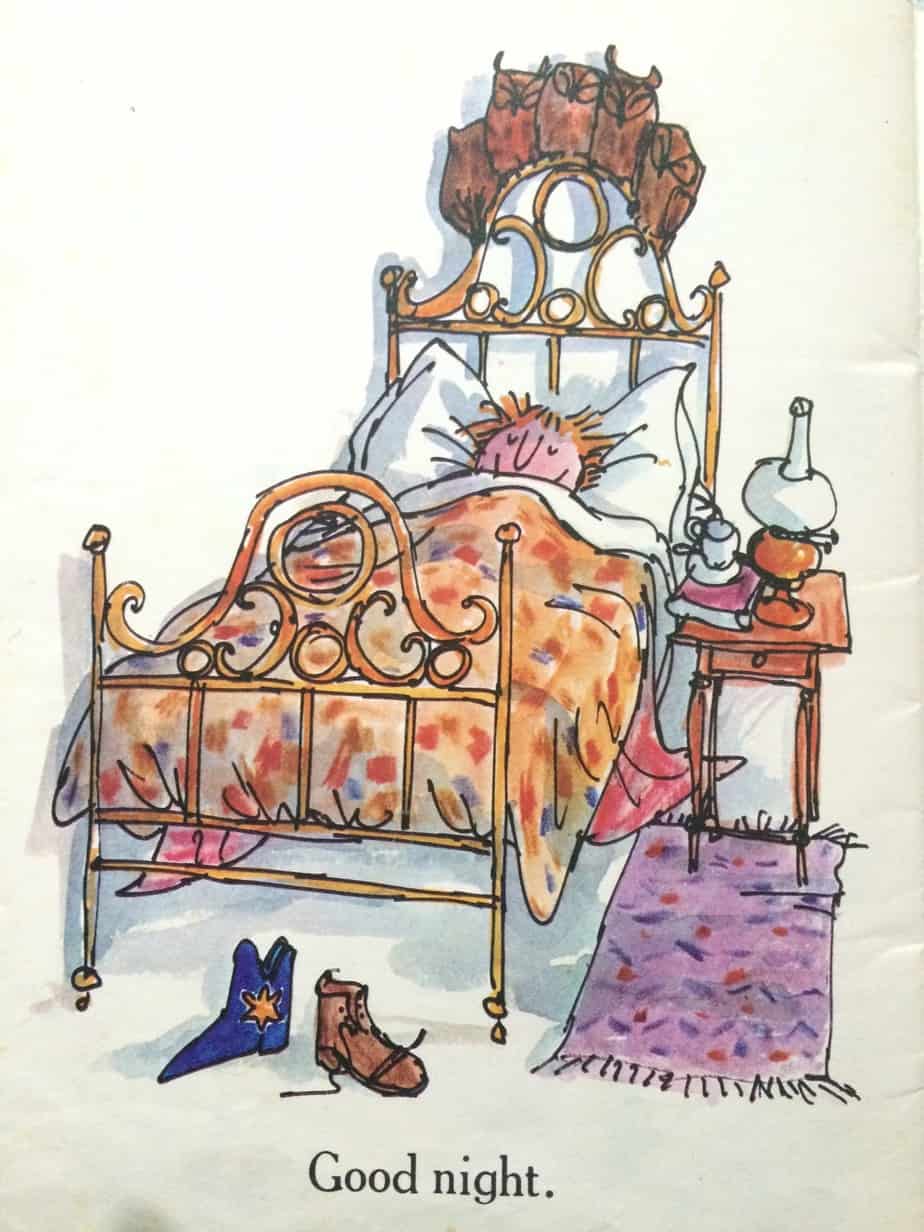
MAGNOLIAS

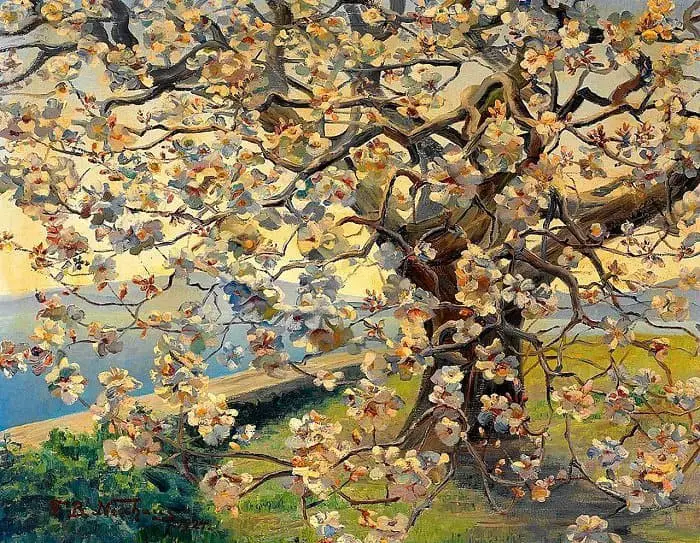
Although the magnolia is a well-known flower, it’s not all that common. That describes Blake’s Mister Magnolia character, right? Well-known in the neighbourhood, but beautifully unusual.
Magnolia flowers are also thought to be symbols of femininity, dignity and purity. It comes in a wide variety of colours.
